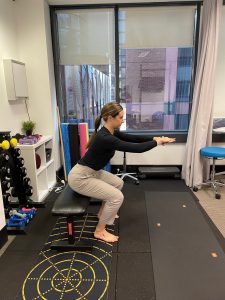Hip pain is a common condition that can present at various times throughout a person’s lifetime. Pain may result from an acute sporting injury, a chronic condition, or even the result of muscular tightness from sitting too much!
Whatever the reason, hip pain requires a thorough diagnostic assessment to identify the specific cause and rule out other possible pain referring structures like the lower back or posterior pelvic joints. Hip pain is an interesting and sometimes challenging condition for physiotherapists to treat as there are so many structures found in a small area (muscles, ligaments, nerves, arteries, bone, joints, connective tissue). Therefore therapists must ask lots of questions to make sure they get the diagnosis right!

Assessment Process for labral injury:
Questions that are important for a physiotherapist to ask are:
- The location, type (sharp/dull), duration of the pain?
- What activities aggravate/ease the pain?
- If the pain came on following an acute injury, or was it an insidious onset?
- Any past injuries or significant medical history?
- Ruling out of red flags – tingling, numbness, muscular weakness, bladder/bowel dysfunction
The physiotherapist will then perform a physical assessment. The assessment involves:
- Reviewing the range of movement at the hip.
- Assessing muscular strength.
- Assessing particular hip structures such as the hip labrum.
Out of all the structures surrounding the hip labral injuries are one of the most common conditions seen in the clinic. The hip labrum is a fibrocartilaginous structure that surrounds the outside rim of the hip socket. The labrum deepens the hip socket and assists the head of the femur to move smoothly inside the hip joint. Labral abnormalities are a natural part of aging; however, through either a traumatic injury or repetitive movements, tears can develop, which, if left untreated, can begin to cause significant pain and prevent you from enjoying your favourite activities.
Symptoms of labral tears:
- Usually, insidious outset, however, can present following acute trauma
- Anterior/ posterior hip pain
- Anterior groin pain
- Pain around the side of the thigh (Greater Trochanter) and buttocks
- Painful clicking, clunking, catching, or locking of the hip
- Night pain
- Limited and painful hip movement
How is it diagnosed:
Labral tears are diagnosed by the presenting symptoms and positive findings in particular orthopedic tests, including the Fitzgerald Test, FADDIR test and McCarthy Sign. In these tests the patient’s thighbone is moved around the edges of the hip socket to see if there are painful points along the labrum – which can indicate a labral tear . Additional imaging can also be performed to confirm a diagnosis. While MRI has traditionally been used to diagnose Labral Tears, recent research shows that it can provide false positives. Currently, Magnetic Resonance Angiography (MRA) (which is usually used to show arteries and veins) is thought to give a more accurate diagnosis.
Treatment for labral tears:
Treatment of Labral Tears begins with conservative management. This involves physiotherapy treatment consisting of manual therapy, rehabilitation exercises, and education. Early rehabilitation exercises focus on minimizing pain and inflammation while maintaining strength within the hip region. Isometrics exercises in all directions can be performed as well as strengthening for the deep abdominal muscles. Once pain levels have decreased, the difficulty of rehabilitation exercises can be increased to include more challenging activities, including walking with resistance bands and the Copenhagen side plank. Advanced rehab exercises include elevated psoas marches, standing clams, and finally, box squats and deadlifts to a block. Once a person has progressed through the phases of rehab and is experiencing minimal pain, we can review the full return to sport.
Advanced rehab exercises:
- COPENHAGEN SIDE PLANK

- STANDING PSOAS MARCH

- STANDING CLAMS

- BOX SQUATS

Conservative management involvement physiotherapy is usually required for a minimum of six weeks. If there is no or reduced improvement in symptoms during this time, the physiotherapist will then discuss the possibility of surgical intervention and refer you onwards to an orthopedic surgeon.
Post by: Physiotherapist Sarah Loveband




